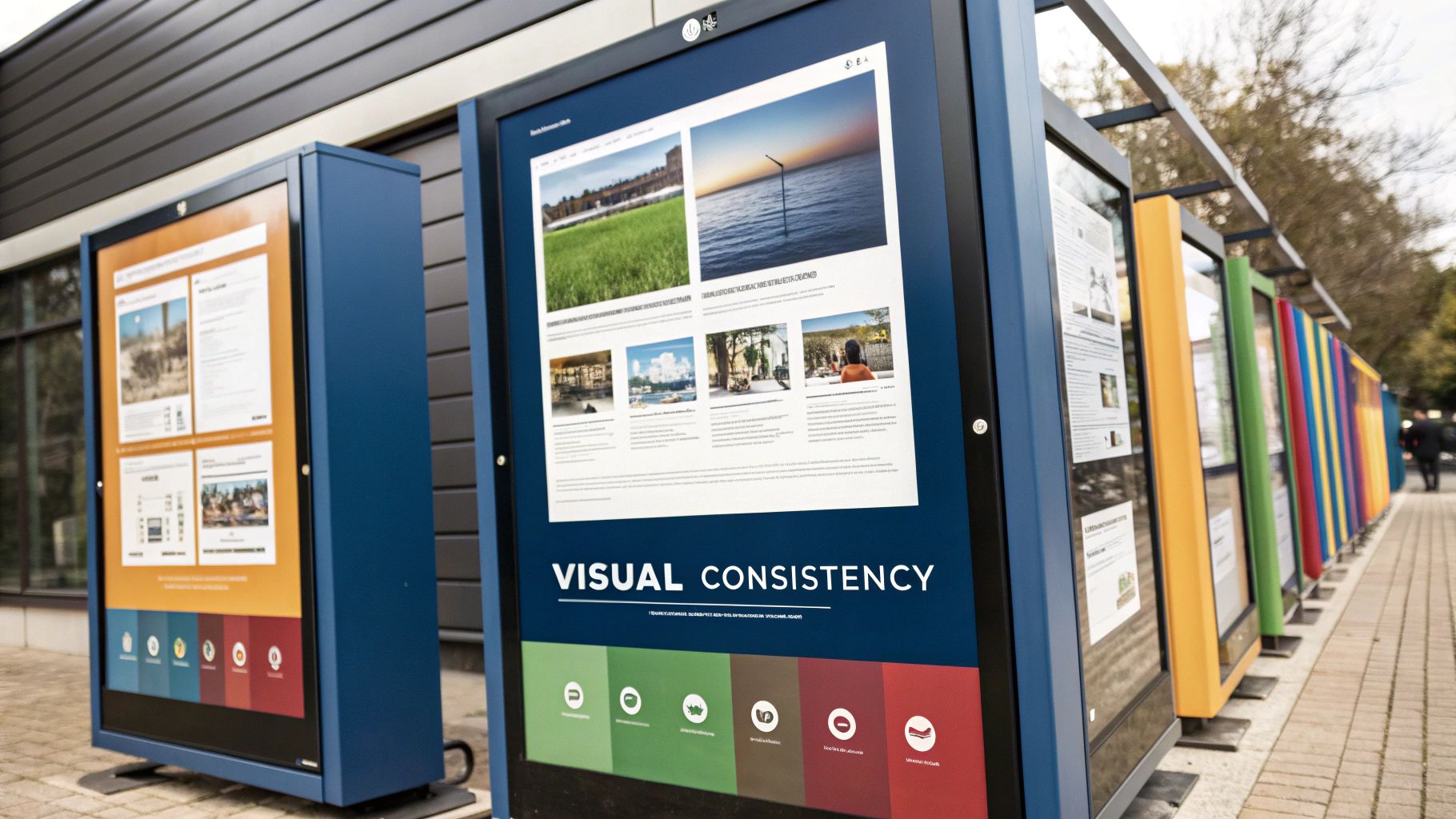Best Practices for Responsive Web Design: A Practical Guide to Driving Real Results
Understanding the ROI of Responsive Design

When evaluating web development investments, responsive design delivers clear and measurable benefits to your bottom line. By understanding exactly how responsiveness affects key metrics like conversions and engagement, you can make smarter decisions about allocating your web development resources. Let's examine the specific ways responsive design impacts business results.
How Responsiveness Impacts User Behavior
The way your website adapts to different screens directly shapes how users interact with it. A smooth, consistent experience builds trust and keeps visitors engaged, while clunky layouts that break on mobile lead to quick exits. This matters more than ever since mobile devices now make up over 60% of all website visits. Getting responsive design right has become essential for connecting with the massive mobile audience.
Measuring the Tangible Benefits
The numbers clearly show responsive design's positive impact on key metrics. Companies that implement responsive sites see sales increase by up to 62% on average. Their conversion rates also outperform non-responsive sites by 11% – a direct boost to revenue. Mobile users engage more deeply too, with responsive sites generating 15% more unique clicks as people find it easier to navigate and take action.
Avoiding the Pitfalls of Non-Responsive Sites
Poor mobile optimization comes at a steep cost. According to web designers, 73.1% of visitors will abandon a non-responsive site immediately. Beyond just losing potential customers, a broken mobile experience damages how people view your brand, making them question your credibility and professionalism. This means responsive design isn't just about winning new business – it's crucial for keeping existing customers happy and loyal.
Building a Business Case for Responsive Design
The financial advantages of responsive design go beyond just better sales numbers. Managing a single responsive site costs significantly less than maintaining separate mobile and desktop versions. Updates and fixes only need to be done once, saving both time and money. There's also the SEO benefit, since search engines give higher rankings to mobile-friendly sites. This improved visibility brings more organic traffic, creating a cycle of increased returns on your responsive design investment.
Implementing a Mobile-First Strategy That Works
With mobile devices now making up over 60% of website traffic, putting mobile users first has become essential for success. This requires more than just scaling down desktop designs – it demands rethinking how we approach web design from the ground up to create the best possible experience for mobile users.
Content Prioritization and Navigation
When designing for mobile, you need to be selective about what content to include. Start by asking "What do mobile users absolutely need to see?" This often means removing extra elements to highlight your core message and features. Navigation should be simple and easy to use – think large, thumb-friendly buttons and clean dropdown menus that users can access without frustration. This focused approach helps boost engagement and conversions on small screens.
Touch Interactions and User Testing
Mobile interfaces need to work seamlessly with touch controls. Make buttons and links large enough to tap comfortably, with enough spacing to prevent accidental clicks. Common touch gestures like swiping and pinching can make the experience feel more natural. Getting real feedback from users on different devices is key – it helps catch usability issues early on, saving time and headaches later. Regular testing ensures your mobile design actually works well for real people.
Responsive Breakpoints and Image Optimization
Smart breakpoints help your design adapt gracefully across screen sizes. For example, you might use a single column on phones, two columns on tablets, and three columns on desktop. Images need special attention too – serving properly sized versions for each screen width keeps load times fast. This matters because slow sites frustrate mobile users and hurt conversions. The details make a big difference in creating a smooth experience that keeps visitors engaged.
Content Hierarchy and Design Integrity
Your key content and calls-to-action should stand out clearly no matter the screen size. This may mean adjusting text sizes, moving elements around, or hiding less important items on mobile. At the same time, your site's overall look and feel needs to stay consistent and professional across devices. When you get these fundamentals right, you create an experience that works well for all users while driving real business results through higher engagement and conversions.
Creating User Experiences That Keep Visitors Engaged
When building a website that works across devices, technical aspects are just the starting point. The real key is understanding how people actually use your site. Research shows that 89% of visitors will leave after just one bad experience – which means getting the user experience right is crucial for keeping people engaged and converting them into customers.
Understanding User Behavior Across Devices
People interact differently with websites depending on what device they're using. Mobile users often need quick answers while on the go, but desktop users typically have more time to explore detailed content. This means we need to adapt not just how the site looks, but what information we present first. For example, a mobile user looking up a restaurant probably wants to see the address and hours immediately, while someone on desktop might want to browse the full menu and photo gallery. By considering these real usage patterns, we can create experiences that make sense for how people actually use different devices.
Leveraging Data to Optimize Engagement
The best way to improve user engagement is to look at how people are actually using your site. Heat maps show exactly where visitors click and scroll, revealing which content catches their attention. Session recordings let you watch how real users move through your site, exposing any confusing or frustrating moments. Conversion tracking helps identify which design elements successfully guide users to take action, like making a purchase. Using this data helps focus improvements on changes that will make a real difference.
Design Elements That Drive Engagement
Think of your website like a physical store – clear signs and a logical layout help customers find what they need. The same principles apply online. Clear calls-to-action guide visitors toward key goals. Simple navigation helps people find information quickly. Even small details matter, like making sure menu buttons are large enough to tap easily on mobile. High-quality images and videos can also explain things more effectively than text alone, keeping visitors interested and helping them understand your message.
Testing and Optimization: A Continuous Process
Building an engaging website isn't a one-time project – it requires ongoing attention and refinement. Regular testing across different devices helps catch issues early. Analyzing user data reveals new opportunities for improvement. As technology changes and user expectations evolve, your site needs to adapt. Just like maintaining a garden requires consistent care, keeping your website engaging takes ongoing effort. But this investment pays off through better user experiences and business results. The key is making incremental improvements based on real user feedback and behavior.
Mastering Performance Optimization
Performance makes or breaks a responsive website's success. Even the most beautifully designed responsive site will fail if it loads too slowly and drives visitors away before they see your content. Fast loading times and smooth interactions keep users engaged and help turn visits into conversions.
Optimizing Images for Peak Performance
Images often cause the biggest slowdowns on responsive sites, especially for mobile users on limited bandwidth connections. Just like carrying a heavy suitcase slows you down compared to a light backpack, large image files drastically increase load times.
Here's how to optimize images effectively:
-
Use Modern Image Formats: New formats like WebP compress images better than JPEG or PNG while keeping quality high. The smaller file sizes mean faster loads.
-
Serve Responsive Images: Deliver images sized for each device. Showing a huge desktop image on mobile is like using a billboard when a poster would do – it wastes bandwidth and slows things down.
-
Apply Smart Compression: Tools that compress images without major quality loss can shave valuable seconds off load times. Like vacuum-sealing clothes for travel, good compression reduces size while preserving what matters.
Writing Clean, Fast Code
Just as image optimization matters, clean code is essential for speed. Extra code weighs down your site like carrying unnecessary items in a backpack. Here's how to keep your code fast and efficient:
-
Minify and Combine: Remove extra spaces and line breaks from code files, then combine multiple files into one. This reduces the number of files browsers must download.
-
Load Scripts Smartly: Let browsers load scripts in the background while rendering the page. This prevents scripts from blocking and slowing down the initial page display.
-
Handle Render Blocking: Find and fix elements that delay page rendering. Load critical content first and defer anything that can wait.
Tracking Site Speed
Regular performance monitoring helps catch and fix slowdowns early. Like checking your car's vital signs prevents breakdowns, tracking site speed helps avoid problems. Use tools like Google PageSpeed Insights to:
-
Find Slow Areas: Identify specific elements and resources causing delays. This shows you exactly what needs optimization.
-
Measure Progress: Check speed metrics regularly to see if your changes help. Real data guides better decisions.
-
Prevent Issues: Catch potential problems before users notice them. Quick fixes keep the experience consistently smooth.
Following these best practices helps create responsive sites that not only look great but perform excellently too. When sites load fast and run smoothly across all devices, users stay longer and are more likely to take action.
Designing Mobile Elements That Drive Conversion
Creating effective mobile interfaces demands rethinking how users interact with content on smaller screens. Rather than just scaling down desktop elements, successful mobile design focuses on building experiences that smoothly guide users toward taking action.
Navigation That Guides, Not Confuses
Simple, clear navigation is essential on mobile devices. Users need to find what they want in just a few taps. While hamburger menus can save space, they sometimes hide important options from view. A better approach is using a tab bar for main navigation sections, making them instantly visible. Think of it like setting up signs in a store – when customers can easily spot what they need, they're more likely to make a purchase. Clear labels and visual cues help users move confidently through your site.
Touch Targets That Encourage Interaction
Mobile users interact through touch, so button and link sizes really matter. We've all felt that frustration of trying to tap a tiny button on our phones. Research shows the average fingertip measures about 10mm wide – roughly 48 pixels. Make your touch targets at least this size so users can tap comfortably without mistakes. Don't forget to add enough space between clickable elements too. These small details add up to create a smooth, enjoyable experience that keeps users engaged and boosts conversions.
Content Strategies for Smaller Screens
Mobile content needs more than just resized text – it requires careful organization and presentation. Mobile users often scan for specific details rather than reading long passages. Break up your content with clear headings, bullet points, and short paragraphs to highlight key information. For instance, if someone wants a restaurant's hours, that information should be prominently displayed, not buried in paragraphs of description. This approach respects how people actually use their mobile devices and helps them find what they need quickly.
Real-World Examples and Testing Strategies
The impact of good mobile design shows up clearly in the numbers – studies find that mobile-optimized sites see 68% more conversions compared to non-optimized versions. To ensure your design works well, test thoroughly across different devices and screen sizes using tools like BrowserStack and CrossBrowserTesting. Try A/B testing elements like button placement and colors to see what connects best with your users. Let real data and feedback guide ongoing improvements to keep your mobile experience driving strong results.
Building Future-Ready Responsive Frameworks
Getting a website to work well on today's devices is only the first step. The real challenge lies in making sure it can adapt smoothly as technology changes. Smart planning now helps avoid expensive redesigns later while keeping your site competitive. This means thinking carefully about how to structure your responsive design to handle whatever comes next.
Designing for an Unknown Tomorrow
Web technology never stands still. Each year brings new devices, browser updates, and changing user needs. Your responsive design needs to roll with these changes – like a suspension bridge that can handle both current traffic and future growth. The key is building flexible components that you can update or swap out without breaking everything else.
Take foldable phones, for example. These devices introduced totally new screen shapes that many sites weren't ready for. But websites built with flexible grids and smart media queries could adapt their layouts automatically, preventing awkward crops and stretched content. This kind of forward-thinking design keeps sites working smoothly as technology evolves.
Prioritizing Maintainability and Scalability
Good code is like a well-maintained car – it runs reliably for years with proper care. When building responsive sites, clean, organized code makes future updates much easier. It helps developers quickly fix issues and add features without creating technical headaches. As your site grows, your framework should handle more traffic and content while staying fast and stable.
Think of it like building with blocks – you want pieces that fit together cleanly and can be rearranged as needed. Using reusable components lets you add and modify features without starting from scratch each time. This approach saves time and keeps your site consistent as it grows.
Embracing Continuous Testing and Iteration
Regular testing across different devices and browsers helps catch problems early. This is especially important given how many different mobile devices are out there. Setting up automated tests can help ensure everything works consistently. It's much better to find and fix issues before users run into them.
Getting feedback from real users is just as important as technical testing. Watch how people actually use your site and what frustrates them. Use analytics to spot patterns and pain points. Like regular oil changes keep a car running smoothly, steady improvements based on real data keep your site working well for everyone.
Investing in a Robust Foundation for Success
Taking time to build a solid responsive framework pays off in the long run. When you focus on flexibility, maintainability and thorough testing, you create a foundation that can handle change gracefully. This thoughtful approach improves the user experience while saving time and money by avoiding major overhauls down the road.
Want to gain deeper insights into optimizing your website's performance? DebugBar offers comprehensive tools and resources for web developers and marketers to enhance their website's functionality and stay ahead of the curve. Check out DebugBar today to learn more.


